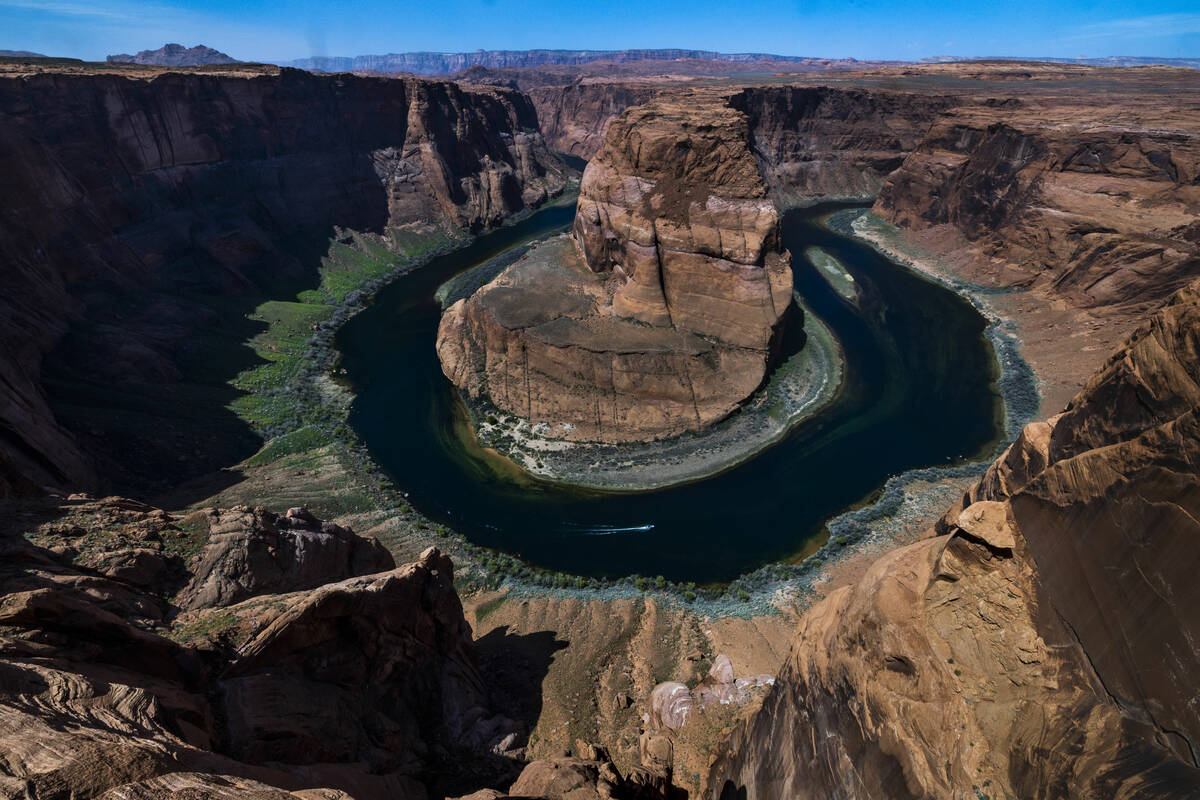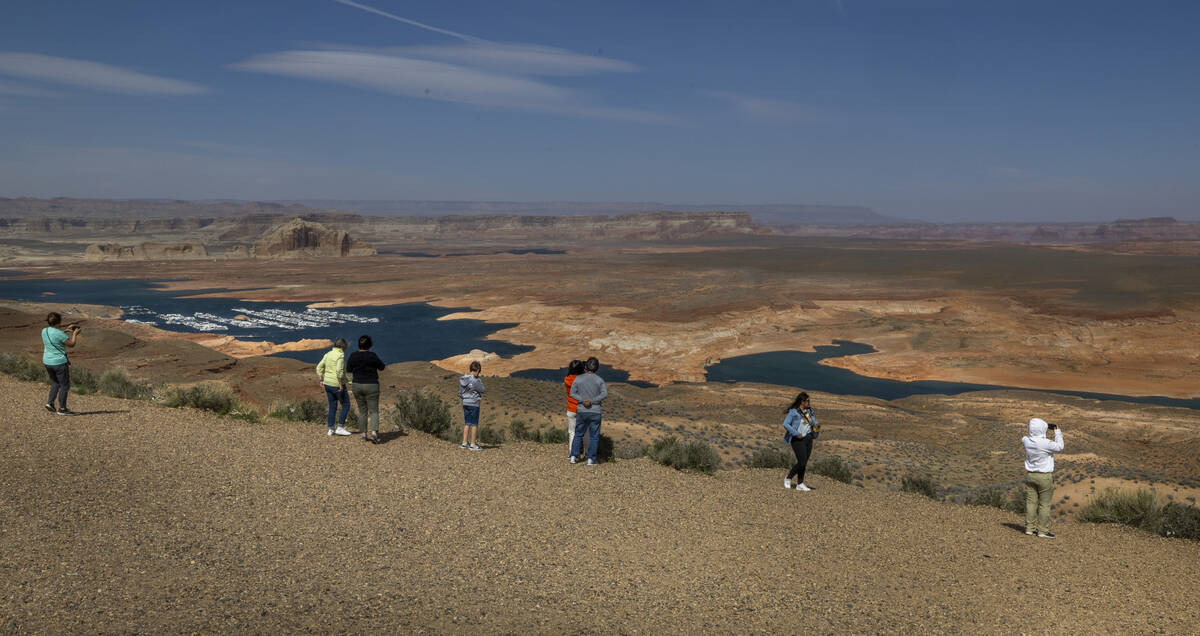‘Important deal’: States agree on water cuts to boost Colorado River
Nevada, California and Arizona have reached an agreement on a plan to significantly reduce water use along the Colorado River, a deal that comes after nearly a year’s worth of negotiations over how to save the crumbling river system that provides water to roughly 40 million Americans.
The agreement, announced by the U.S. Department of Interior on Monday, would see the states that make up the Lower Colorado River basin cut their water allocations by as much as 3 million acre-feet by 2026, with half of those savings coming by the end of 2024.
Roughly three-quarters of those reductions — about 2.3 million acre-feet — would be compensated through funding from the federal government’s Inflation Reduction Act.
The plan, which still needs to be reviewed and approved by the federal government, is meant to be a bridge to protect the system while permanent guidelines for the river’s operations that would take effect after 2026 continue to be hashed out. But whether the newest proposal to temporarily reduce use in the lower basin will be enough to keep the river system from worsening remains to be seen.
“I do think this proposal gives us what we need over the next three years, which is critical,” John Entsminger, general manager of the Southern Nevada Water Authority, said in an interview Monday. “We have serious work to do in terms of longer-term, more durable solutions to be implemented post-2026. It’s an important deal reached by the states today because it gives us the room to work on those longer-term problems.”
Under the plan, Nevada would commit to keeping 285,000 acre-feet of water in Lake Mead over the next four years, starting with 75,000 acre-feet in conservation this year, Entsminger said.
Southern Nevada, which gets about 90 percent of its water from the Colorado River, has been aggressive in reducing its overall water consumption through programs like paying residents to remove their thirsty grass.
In 2022, Nevada consumed about 225,000 acre-feet of water from the Colorado River, or about 75,000 acre-feet under its normal 300,000-foot allocation, and the latest projections from the federal government show Nevada using just 212,000 acre-feet this year.
Between those efforts and unused apportionments from the Virgin and Muddy rivers, the water-saving commitments under the plan would “not have a real impact on the day-to-day lives of Southern Nevadans,” Entsminger said.
Praise from elected officials
California, the Colorado River’s biggest user, would shoulder more than half of the reductions, with commitments to save 1.6 million acre-feet of the river’s waters over the next four years, JB Hamby, chairman of the Colorado River Board of California, said in a statement.
Elected officials from Nevada, Arizona and California praised the deal Monday, including each state’s governor.
“Through this partnership, we look forward to equitably advancing our mutual goal of conserving our shared water resources,” Gov. Joe Lombado said in a statement. “It’s never been more important to protect the Colorado River System, and this partnership is a critical next step in our efforts to sustain this essential water supply.”
The proposed cuts put forward by the states, though, are far less than what the federal government previously said was needed to protect the river and its critical infrastructure at its biggest reservoirs, Lake Mead and Lake Powell, which had fallen to historic lows last year amid two-plus decades of crippling drought coupled with chronic overuse.
“Clearly this remains a Band-Aid on a gaping wound because the long-term problem of needing to reduce our use still remains,” John Fleck, a water researcher at the Utton Center at University of New Mexico School of Law, said in an interview Monday.
In June of last year, Bureau of Reclamation Commissioner Camille Touton said the states needed to reduce water use along the river by as much as 2 million to 4 million acre-feet per year. But the states failed to reach agreement as multiple federally imposed deadlines came and went since Touton’s initial comments.
One such deadline came at the end of January, when California submitted a separate proposal from the other six basin states, which had put forward their own joint proposal to the federal government to be analyzed as part of the Bureau of Reclamation’s process for replacing 2007 interim guidelines for the river’s operations.
‘Feels like a missed opportunity’
While they arrived there through different routes, both proposals called for a similar amount in total cuts in the lower basin — up to 2 million acre-feet in reductions annually split between Nevada, California and Arizona.
Those plans met the low end of Touton’s call for cuts, and the newest proposal from the states amounts to less than half of that. A pair of alternatives unveiled by the federal government last month were partly based on the two proposals from the states.
“This whole thing feels like a missed opportunity. We were on the verge of serious discussions on deep cuts along the Colorado River that are needed. And we got a big snowpack which put off the hard cuts once again,” Fleck said. “The reason Lake Mead and Lake Powell were crashing seriously a year ago is because we’ve done the same thing over and over and over again.”
The Colorado River basin experienced a far-better-than-average winter this year as atmospheric river after atmospheric river moved through the West and swelled the snowpack in the Rocky Mountains to near-record levels. The amount of water that makes its way into the Colorado River from that snowmelt this spring and summer is projected to be the highest in at least a decade, which in turn has led to improved forecasts for water levels at Lake Mead and Lake Powell.
This year was not the first wetter-than-normal year for the river during the current 23-year drought in the basin. But those years were followed by historically dry periods, and the river’s overall natural flows are roughly 20 percent lower than the 20th century average.
Despite a smaller per-year reduction as compared with the other alternatives that have been under review, officials believe the newest proposal from the states will actually keep more water in Lake Mead, the nation’s largest reservoir, which currently sits at 30 percent of its capacity.
Entsminger, from the Southern Nevada Water Authority, said that is partly because the newest proposal calls for conservation efforts to begin this year, while the federal alternatives would not have kicked in until 2024.
“By the end of 2026, this plan results in higher reservoir elevations than either of those plans would,” Entsminger said.
‘Another stopgap measure’
Kyle Roerink, executive director of the Great Basin Water Network, a group that advocates for water conservation in Nevada and Utah, called Monday’s announcement “another stopgap measure” that is aimed more at quelling hostilities between the states than addressing the long-term health of the river.
“The bureaucratic machinations between now and 2026, however, must finally address the reality that tomorrow’s means of river management won’t be adequate 10 years from now. The math of this deal appears to be an attempt by the Lower Basin to address the structural deficit and other accounting shortcomings for the near-term. The long-term equation — with climate change devastating river hydrology at every turn — is much more difficult to solve,” Roerink said in a statement.
With a deal struck between the lower basin states, the Department of Interior said it is temporarily withdrawing a set of cut options laid out by the federal government last month “so that it can fully analyze the effects” of the states’ new consensus proposal.
“It’s heartening to me that the Bureau of Reclamation feels that this is an adequate amount to model going forward,” said Elizabeth Koebele, an associate professor at University of Nevada, Reno who studies water policy and governance. “Primarily because it lets the states sort of put a bow on this emergency conservation measure, and at the same time it sort of gives them the chance to pivot to thinking post-2026.”
But Koebele cautioned that the final plan could still change because the federal government is not obligated to adopt the proposal wholesale.
The Department of Interior said the next steps in the review process for the proposed cuts will come early next month.
Contact Colton Lochhead at clochhead@reviewjournal.com. Follow @ColtonLochhead on Twitter.
Lower Basin Plan Letter Final 5-22-2023 by Colton Lochhead on Scribd




















